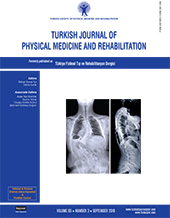Dynamic stretching does not affect peroneal and tibial muscle reaction properties
2 Department of Sports Medicine, Diyarbakır Gazi Yaşargil Training and Research Hospital, Diyarbakır, Turkey DOI : 10.5606/tftrd.2019.3179 Objectives: This study aims to investigate acute and chronic effects of dynamic stretching on peroneal and tibialis anterior reaction properties.
Patients and methods: Between September 2015 and June 2017, a total of 21 male athletes (mean age 22.6 years; range, 20 to 30 years) were included in this study. All participants were randomly divided into two groups as dynamic stretching group (n=11) and control group (n=10). The participants in the dynamic stretching group performed stretching exercises for the ankle evertor and dorsiflexor muscles five days a week for six weeks. Peroneal and tibial muscle reaction properties were evaluated at baseline (two times for acute effect) and at the end of the intervention. Electromyographic activity parameters including reaction time, reaction duration, and reaction magnitude of the muscles were measured using an ankle supination tilting platform. There were four different supination conditions: (i) ankle neutral, 15° inversion (0015), (ii) ankle neutral, 30° inversion (0030), (iii) ankle 20° plantarflexion, 15° inversion (2015), and (iv) ankle 20° plantarflexion, 30° inversion (2030).
Results: There were no significant differences in acute and chronic effects of dynamic stretching exercises for peroneal and tibial muscle reaction time, reaction duration, and muscle activity in four positions on the ankle inversion simulation platform (p>0.05).
Conclusion: Our study results suggest that dynamic stretching exercises have no positive or negative effects on muscle reaction properties and on the possible risk of ankle sprain during sudden ankle inversion. Dynamic stretching exercises may still be preferred for sports where strength and force effects are important.
Keywords : Ankle sprain, dynamic stretching, electromyography, muscle latency

















